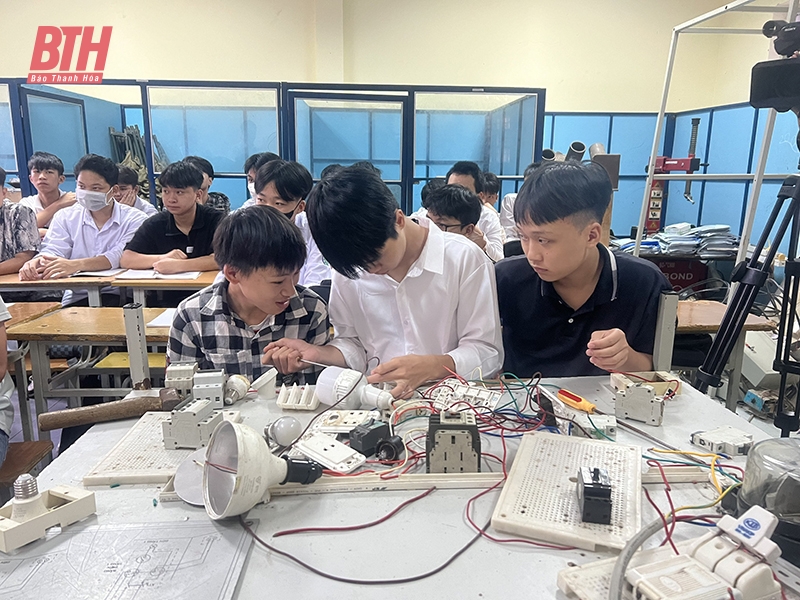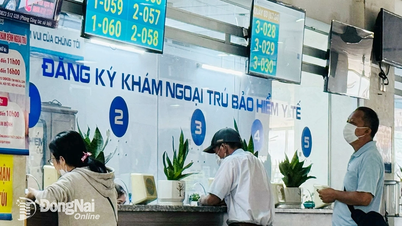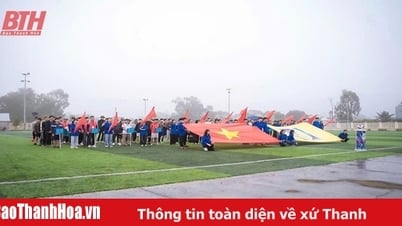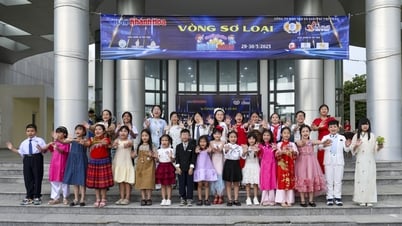Students of Bim Son Vocational College practice electrical engineering in class - combining theoretical training with professional practice.
The inevitable direction
In the context of economic integration and rapid technological development, the labor market requires human resources not only to have professional knowledge but also to be proficient in practical skills and to adapt quickly to the working environment. To meet this requirement, vocational training institutions have been strongly implementing the model of training cooperation with enterprises. Training cooperation between schools and enterprises helps students access production practices, improve their professional skills and soft skills, and at the same time create favorable conditions for finding jobs after graduation.
With over 65 years of establishment and development, Thanh Hoa College of Commerce and Tourism is one of the typical vocational training units of the province in effectively implementing the training linkage model. In order to meet the practical requirements of the labor market, the school has proactively surveyed the labor needs of enterprises and localities, thereby adjusting the curriculum and expanding appropriate training majors such as: food processing techniques, hotel and restaurant operations, tour guides, family care services, receptionists...
During the training process, students not only learn theory but also practice and intern at large tourism establishments, hotels, and service enterprises in the area. At the same time, the school also promotes coordination with localities such as Hoang Hoa, Hau Loc, Cam Thuy, and Sam Son City to deploy vocational training according to orders, linking training with on-site job creation. Thanks to these efforts, in 2024, the school enrolled and trained nearly 2,000 students, reaching 110.3% of the plan and an increase of 8.8% over the same period. The rate of students having jobs after graduation has always remained high, nearly 100%, affirming the clear effectiveness of the training model associated with practice.
Bim Son Vocational College is also a typical example of training cooperation. The school has cooperated with many enterprises to train in occupations such as welding, automobile technology, fashion sewing, refrigeration and air conditioning engineering. Since its establishment, the school has trained over 6,000 students, many of whom have been accepted into the company after graduation. Training is closely linked to the actual needs of enterprises, helping students easily find jobs and quickly adapt to the working environment.
Notably, thanks to the close connection with enterprises, students of Bim Son Vocational College can combine learning with practice, no longer feeling vague when entering the labor market. Many students after graduation are retained to work with stable salaries, have opportunities for promotion and improve their skills...
Expanding job opportunities
It can be affirmed that the implementation of the training cooperation model has brought many positive effects to both schools, enterprises and students. Students have access to a real working environment, improve their vocational skills, soft skills and ability to adapt to work requirements, thereby easily finding jobs right after graduation. Many students are also retained by enterprises to work right from the internship stage, shortening the probationary period and stabilizing their lives sooner. For enterprises, this model helps save costs in recruiting and retraining new workers. This cooperative relationship also helps schools expand their enrollment network and increase competitiveness in the context of vocational education increasingly requiring substance.
Job consulting and introduction activities attract a large number of students at Thanh Hoa Industrial College.
According to statistics, the rate of students having jobs after graduation at vocational training institutions implementing the joint training model reaches from 80% to 95%, especially many industries such as food processing, industrial electricity, automotive technology... reach 100%. This is a clear demonstration of the effectiveness and sustainability of this model.
To continue promoting the effectiveness of the training cooperation model and meet the increasing demands of the labor market, in the coming time, vocational training institutions need to continue to synchronously deploy many solutions in both depth and breadth. First of all, it is necessary to expand cooperative relationships with enterprises. Not only stopping at sending students for internships or coordinating recruitment, schools need to proactively coordinate with enterprises right from the stage of building training programs. This helps ensure that teaching content is close to production and business practices, creating conditions for students to have appropriate skills immediately after graduation. At the same time, it is necessary to encourage enterprises to participate in the teaching process in the form of inviting experts and technical engineers to be guest lecturers, supporting practice and reality in the factory.
At the same time, investment in modern training facilities and equipment is an urgent requirement. Vocational schools need to take advantage of public investment capital, international cooperation, and at the same time promote socialization to gradually modernize practice rooms and simulate actual production processes. This not only improves training quality but also helps students practice skills close to the business environment.
It can be affirmed that the model of cooperation between schools and enterprises is gradually transforming vocational education in a practical, effective and sustainable direction. In the context of increasingly high labor competition, this is the "key" for vocational education institutions to affirm their role, accompany enterprises and contribute to improving the competitiveness of the local economy. Continuing to replicate and upgrade this model is not only an inevitable requirement but also a long-term strategy to build sustainable human resources for the future.
Article and photos: Tran Hang
Source: https://baothanhhoa.vn/tu-giang-duong-den-nha-may-nbsp-khi-hoc-nghe-bat-nhip-voi-thuc-tien-250282.htm





![[Photo] General Secretary To Lam receives Chief of the Central Office of the Lao People's Revolutionary Party](https://vphoto.vietnam.vn/thumb/1200x675/vietnam/resource/IMAGE/2025/5/30/140435f4b39d4599a3d17975dfb444c5)
![[Photo] National Conference "100 years of Vietnamese Revolutionary Press accompanying the glorious cause of the Party and the nation"](https://vphoto.vietnam.vn/thumb/1200x675/vietnam/resource/IMAGE/2025/5/30/1cf6cd5c8a934ebfa347028dcb08358c)

![[Photo] Journalists moved to tears at the Memorial Service for the soldiers who died in Gac Ma](https://vphoto.vietnam.vn/thumb/1200x675/vietnam/resource/IMAGE/2025/5/30/9454613a55c54c16bf8c0efa51883456)
![[Photo] A delegation of 100 journalists from the Vietnam Journalists Association visits the soldiers and people of Truong Sa island district.](https://vphoto.vietnam.vn/thumb/1200x675/vietnam/resource/IMAGE/2025/5/30/0984a986227d4e988177f560d2e1563e)



















































































Comment (0)